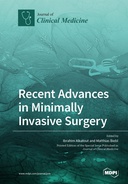Explore

Recent Advances in Minimally Invasive Surgery
0 Ungluers have
Faved this Work
Login to Fave
Minimally invasive surgery has become a common term in visceral as well as gynecologic surgery. It has almost evolved into its own surgical speciality over the past 20 years. Today, being firmly established in every subspeciality of visceral surgery, it is now no longer a distinct skillset, but a fixed part of the armamentarium of surgical options available. In every indication, the advantages of a minimally invasive approach include reduced intraoperative blood loss, less postoperative pain, and shorter rehabilitation times, as well as a marked reduction of overall and surgical postoperative morbidity. In the advent of modern oncologic treatment algorithms, these effects not only lower the immediate impact that an operation has on the patient, but also become important key steps in reducing the side-effects of surgery. Thus, they enable surgery to become a module in modern multi-disciplinary cancer treatment, which blends into multimodular treatment options at different times and prolongs and widens the possibilities available to cancer patients. In this quickly changing environment, the requirement to learn and refine not only open surgical but also different minimally invasive techniques on high levels deeply impact modern surgical training pathways. The use of modern elearning tools and new and praxis-based surgical training possibilities have been readily integrated into modern surgical education,which persists throughout the whole surgical career of modern gynecologic and visceral surgery specialists.
This book is included in DOAB.
Why read this book? Have your say.
You must be logged in to comment.
Rights Information
Are you the author or publisher of this work? If so, you can claim it as yours by registering as an Unglue.it rights holder.Downloads
This work has been downloaded 96 times via unglue.it ebook links.
- 96 - pdf (CC BY) at Unglue.it.
Keywords
- 3D printing
- Anesthetics
- anti-Müllerian hormone
- artificial intelligence
- augmented reality
- autonomic pelvic nerves
- biliopancreatic diversion
- body donors
- cervical cancer
- cholangiocarcinoma
- chronic pelvic pain
- clinical anatomy
- colorectal liver metastases
- conversion rate
- Counseling
- COVID-19
- cysts of the canal of Nuck
- da Vinci
- diaphragmatic hernia
- embryologic development
- Embryology
- endometrial cancer
- endometrial neoplasms
- endometrioma surgery
- endometriosis
- Endoscopic surgery
- Endoscopy
- enterothorax
- esophageal cancer
- esophagectomy
- fetal surgery
- general anesthesia
- genital nerves stimulation
- Gynecology
- health-related quality of life
- hepatectomy
- hepatic metastasis
- hepatocellular cancer
- hepatocellular carcinoma
- hernia repair
- hydrocelectomy
- hysterectomy
- hysteroscopy
- indocyanine green
- intercostal catheter
- intraoperative imaging
- Ivor-Lewis procedure
- laparoscopic
- laparoscopic hysterectomy
- laparoscopic liver surgery
- laparoscopic repair
- Laparoscopic Surgery
- laparoscopy
- learning curve
- Lichtenstein
- LION procedure
- live surgery events
- liver resection
- local recurrence
- lung cancer
- lymphadenectomy
- Machine learning
- malabsorption
- medicine
- mesh
- mesh use
- mesorectal
- Meta-analysis
- minimal invasive surgery
- minimally invasive
- minimally invasive surgery
- minimally invasive surgical procedures
- Mortality
- n/a
- native tissue
- neuropelveology
- notes
- Nuck hydrocele
- oncologic surgery
- one-anastomosis gastric bypass
- open surgery
- Opioid
- ovarian cancer
- ovarian neoplasms
- ovarian reserve
- Pain
- pancreatic surgery
- pancreaticoduodenectomy
- patient-doctor-relationship
- pectopexy
- Pediatric surgery
- pelvic compartments
- pelvic floor
- pelvic floor repair
- pelvic lymphonodectomy
- pelvitrainer
- Perioperative Care
- Platelet-Rich Plasma (PRP)
- PMMR
- postoperative pain control
- prolapse
- prostate cancer
- Quality of life
- radiofrequency pre-coagulation
- Radiotherapy
- real-life imaging
- rectal cancer
- recurrence rate
- regional anaesthesia
- risk score
- robotic assisted surgery
- robotic liver resection
- robotic radical hysterectomy
- robotic surgery
- Roux-en-Y gastric bypass
- SADI-S
- SARS-CoV-2
- sentinel lymph node mapping
- Sexuality
- single-incision surgery
- single-port laparoscopy
- skill assessment
- snorkel mask
- spontaneous pregnancy
- Surgery
- surgical devices
- surgical education
- surgical performance
- Surgical techniques
- surgical training
- Survival
- Survival Analysis
- systematic review
- TAPP
- technical aspects
- thin endometrium
- thoracic surgery
- topographic anatomy
- transanal
- uterine cancer
- uterine cervical neoplasms
- vaginal neoplasms
- vaginal repair
- VATS
- video feedback
- video modeling
- vulvar neoplasms
- weight regain
Links
DOI: 10.3390/books978-3-0365-2100-8Editions

